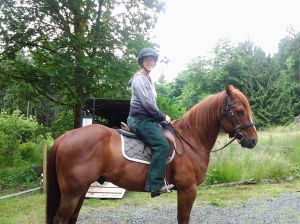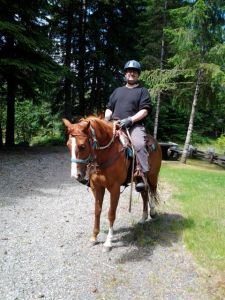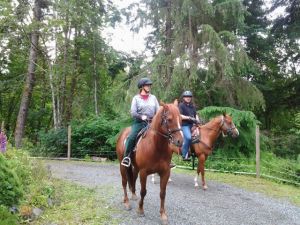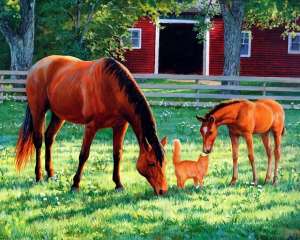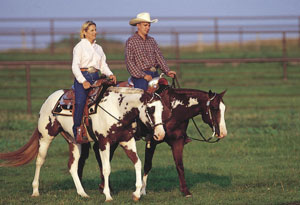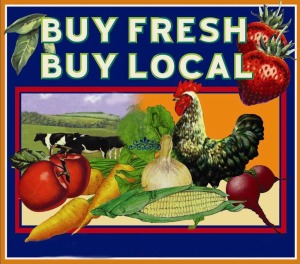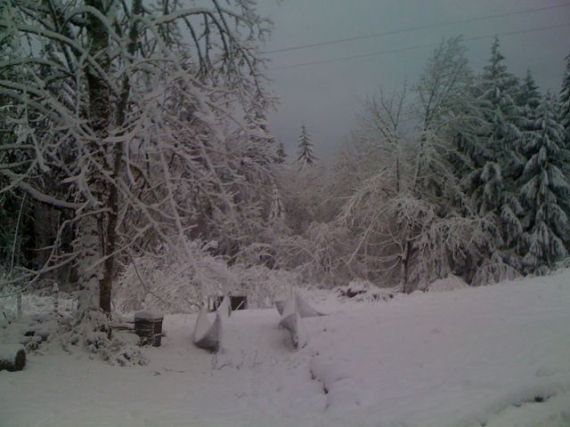
For the last few years I’ve been making a conscious effort to “know my food”: what’s in it, where it comes from, and how it was grown or raised. I eat what I thought was a healthy diet, with limited processed foods, mostly whole foods, and meals made from scratch. Recently my Husband and I have embarked on a rather dramatic change in eating habits. We’re still in transition mode, and I’m still processing my thoughts about it all, but that’s what today’s post is about.
Husband has struggled with his weight for many years. Recently, he brought home a book that changed the way we think about food. Good Calories, Bad Calories by Gary Taubes debunks the myth of low-fat and low-cholesterol being “good for you” diets, and instead points the finger squarely at carbohydrates as the main culprit in the so-called “Western Diseases” (obesity, diabetes, heart disease). He presents some impressive evidence for this, gleaned from credible sources such as scientific papers and government reports. The story of how we all came to believe in the “low fat solution” is a fascinating one all on its own (in a word: politics).
Being thus convinced that a diet heavy in carbs may be unhealthy I started looking into low-carb diets. I soon became overwhelmed with the amount of information out there. There’s low-carb, no-carb, Paleo, GAPS (Gut and Psychology Syndrome), SCD (Specific Carbohydrate Diet) and a host of others. While all of them aim to reduce carbohydrate intake, they differ on what is allowed and not allowed. Some forbid dairy (though others allow butter and/or ghee). Some say lighten up on the nuts and seeds, while others rely on them as grain substitutes. Some forbid all legumes, while others allow certain legumes prepared in a certain way. It all gets very confusing very quickly. Each side has their argument about why such-and-such a food is okay or not and it gets hard to figure out who to believe.

Ultimately, with my head swimming and confused about whether anything I’d ever enjoyed eating was good for me, I had to stop and take a pause and ask myself the most important question, one I heartily recommend anybody else considering a major dietary change ask themselves: why do I want to change the way I currently eat?
Different diets are skewed towards different theories of nutrition and their relation to disease. GAPS, for example, links gut health to mental health, suggesting that autism spectrum disorders can be treated this way. SCD is geared towards those with digestive disorders such as IBS or Crohn’s. Some people claim they are fatigued all the time, suffer from chronic aches and pains, have food allergies or sensitivities. Some are athletes in training looking to maximize performance. Others want to reduce their food budget, or eat with a mind to being more environmentally responsible. Many others are looking to control their weight.
I fall squarely into the last category. I don’t have any health problems. I tolerate wheat and dairy just fine. I am not lacking in energy, and I don’t suffer from chronic pain. By mainstream North American standards, my diet is already pretty darned healthy. However, I am overweight, and possibly more so than I thought. When I was in my early twenties I weighed around 125 lbs. Now, at age 43, I consider an ideal weight for me to be 142 lbs, mostly because that’s the lowest weight I’ve been able to attain without depriving myself of food and going hungry (a miserable way to live, particularly when it’s self-imposed). I simply accepted that one gains weight with age, but the fact is I am not any taller than when I was 23. Based on my ideal weight I am currently about 10 – 12 pounds overweight. However, if one argues that I should be where I was 20 years ago, then I’m actually 25+ lbs overweight. That’s entering scary territory.
I recently watched Robert Lustig’s viral YouTube talk Sugar: The Bitter Truth (it’s worth the whole hour to watch, but you could skip to the last 15 minutes to find the conclusions) and was deeply affected. Having taken my share of biochemistry courses I really appreciated the strength of what he was saying, and it added to my growing suspicion (especially after reading Taubes’ book) that sugar was much more of a problem for me than I wanted to believe. I’ve had a sweet tooth all my life and I love baked goods, breads, and other starchy foods including rice, pasta, and potatoes. Switching to home-made and organic doesn’t change the way they affect weight, however.

So, having decided that weight loss is my primary goal and that sugars (including starches) may be my main issue, I considered any other desires I might have for a new dietary regime. I do exercise, going for long walks and bike rides regularly, and doing hard labour on our property in the warmer months. I do NOT want to have to exercise simply for the sake of burning calories: that has never worked for me. I don’t want to be counting the hours that I walk, the steps I take each day, nor do I want to be counting calories or going hungry at any time during the day. So, with these considerations in mind I decided to go for the Paleo diet, which eliminates all grains. Fruits are okay (Lustig says the presence of so much fibre affects how the body handles the fructose, for the better), and it meshed well with Husband’s decision to go low-carb and grain-free. The philosophy also appeals to me since I tend to look towards our evolutionary history when trying to answer other questions in my life such as how to care for my babies (thus, attachment parenting), or how children learn (thus, unschooling).
I’ve been in a transition period for the last few weeks: trying to wean myself off sugar, move away from grains, and transition to new recipes. I’m glad I tried this slowly; I think it has made it easier to accept and adapt. For example, this morning for the first time in over 20 years I did not start off my day with a cup of black tea. I used to put tons of sugar in my morning cuppa, but over the last few weeks I’ve weaned myself down to only a teaspoon in a large mug. However, truth be told it’s just not enjoyable anymore. I find black tea too bitter. So instead I had some rooibos tea, which goes well with milk and doesn’t need sweetening. My final challenge will be to replace my morning bowl of cereal when I’m finally finished the box.
Lunch has been the easiest. I usually don’t eat much for lunch and I have been enjoying some Hvarti cheese (full fat, wahoo!), a handful of almonds, and a pear or other fruit. Lately I’ve fallen for smoothies. My current favourite ingredients include almond butter, frozen mixed berries, coconut milk, raw cow’s milk, plain yogurt (from raw milk), silken tofu, and spinach. I was adding white grape juice at first but am weaning myself off that now. For snacks a handful of almonds or cashews (or mixed together with raisins) satisfies. Also beef jerky (time to get a food dehydrator).
Dinner meant writing many staples off the list. But it’s also now pretty simple: pick a meat, pick a veg. For meat we choose from beef, pork, chicken, or eggs (all farm-fresh, ethical, local meats). We are also considering joining a CSF (community-supported fishery) so we can get sustainably-caught local seafood. For veggies we either have a tossed salad, broccoli slaw, or stir-fried veggies. No rice, no potatoes, no pasta, no beans, no lentils. Besides making meal planning simpler, I have noticed two main benefits to eating this way. First, I no longer feel uncomfortably full after dinner. I just feel satisfied, not like I need to undo the button on my jeans. I’m also not feeling hungry later on, which I very often did when eating a dish with pasta or rice. The second benefit is that since I can’t fill up on pasta, rice, or potatoes I need to make up for that with more veggies. Thus, a typical meal now consists of a serving a meat and the rest of the plate piled high with greens. I like this; it was the excuse I needed to have more vegetables around.
So we’re still pretty new to this and I’m not 100% Paleo yet. I will allow myself a few “forbiddens” like flaxseed meal (which I eat so little of anyway), and perhaps the odd dash of maple syrup or honey. I’m also fully embracing the dairy, since I have no reactions to it and we have access to raw milk. I also won’t expect to stick to Paleo when eating out, but that is a rarity anyways. And I will treat myself every once in a while, because a life without ever eating rhubarb pie or freshly baked cinnamon buns is simply not worth living. 🙂

